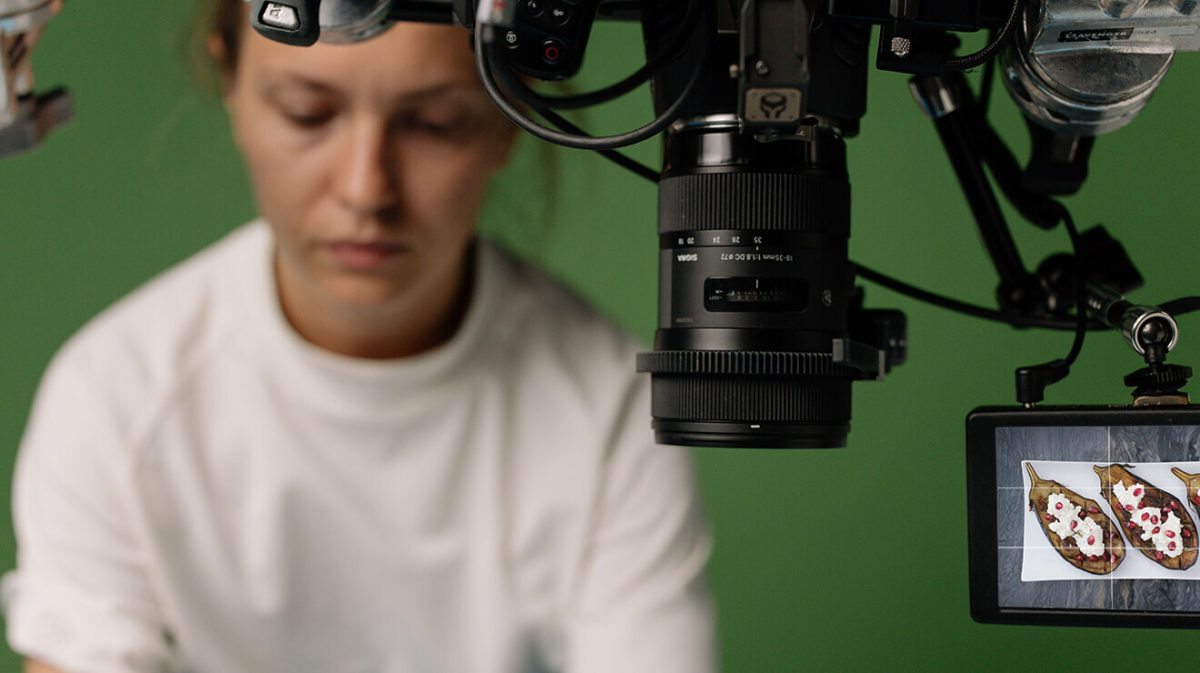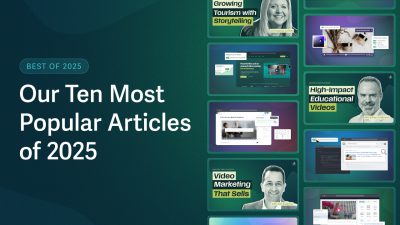What if you want to hop on the video creation bandwagon, but are a little camera shy? Have no fear, there are numerous ways you can create high-quality video content for your business without having to be in front of the camera. In this post, we’ll be breaking down the six types of videos you can produce without showing your face.
1. Tutorial
Tutorial videos and how-to content are some of the best ways to get your message across to your audience. Typically these videos consist of someone walking the audience through a number of steps that help them learn something new.
This works as a faceless video because you can make your product the star. This will require you to film your subject in a way that puts it front and center. This works really well with physical products, food, and more. Typically, you’ll also need either a voiceover or instructions on the screen to help create a cohesive message.
Buzzfeed’s Tasty does this incredibly well with their food series. They consistently put out a well-edited video featuring just the food and the hands that are preparing them. Check out the example below.
2. Screencast
In the same family as tutorials, you have screencast videos. These types of videos have the same general idea of teaching or walking the audience through something but this time it will be through an all-digital format.
This works particularly well for software companies, educational institutions, or application tutorials, but really, anything that you can show on your screen could become a screencast video. Essentially, you’ll use software to record your screen as you work your way through a program. We recommend using QuickTime, Snagit, or ScreenFlow.
The key to making a screencast enjoyable is to treat it as a full-on video. Many think you can wing it and just record your screen as you work your way through the tutorial, but that will result in a less than enjoyable final product. For an in-depth tutorial on how to create a screencast, watch our Screencast How To Video episode for all the necessary steps.
3. Interviews
You may be thinking, how can you do an interview without showing your face? Well, similar to tutorial videos where the product is the focus, you can make your interviewee the focus of this video. This will take the pressure off of you to be on camera.
These types of interview videos work well because bringing in experts in your field will undoubtedly bring value to you and your viewers. The best part is that interviews work for any industry. There will always be thought leaders outside of your organization that you can interview. For this, you’ll need to come up with a comprehensive list of questions, lock in experts, and possibly acquire B-roll to spice things up.
GQ does a variation of this through topical video series with different celebrities and experts sharing their perspectives. GQ producers are never seen on camera, but having various thought leaders and excellent B-roll keeps it fresh. Check out the example below from their series ‘The Breakdown.’
4. Animation
Animation is a tried and true video method that can be used for any industry. This method certainly doesn’t require you or anyone to get on camera since everything will be created with graphics, which is equally a major benefit and a potential drawback. Unless you have someone on your team that is a trained video animator, you’ll have to hire someone, work with a studio, or use an online service to create the video for you.
To get a result as close to your vision as possible you’ll need to provide as much detail to the animation producers as possible. In an ideal world, you would provide a creative brief, script, storyboard, and more.
Another consideration would be the amount of time it takes to produce an animated video. Animation can be really time-consuming depending on the complexity of the project, so lead time will need to be adjusted accordingly.
All that being said, the result should be worth the work. With animation, the sky is the limit. You can create just about anything you can think of. Check out this exceptional video from Ted-ED about understanding coronaviruses. They take a complex topic, infectious diseases, combine it with a solid voice-over and animation to make an easily digestible video for their audience.
5. Stop Motion
An alternate form of animation is stop motion. Stop motion animation is unique in the fact that it involves shooting objects one frame at a time, then combining these shots in post-production to create a video. Typically, it is done with inanimate objects in a way that brings them to life.
Another benefit of stop motion animation versus normal animation is that just about anyone can achieve this look if they have the tools to do so. All you’ll need is an idea, proper lighting, a camera, and a lot of patience. While it may take a fair amount of time to create, the final result is fun and captivating.
Lego is famous for using this technique to bring their products to life, as you can see in their stop motion video below. If you can find a way to create a unique message using elements related to your business, this is a surefire way to stand out.
If this sounds like something you want to try, read our six secrets for stop motion animation for more tips.
6. Stock Footage
If you have an important message to share, but don’t have the resources to film related scenes, stock footage is the way to go. Stock footage is video clips that folks have uploaded online that can be used for free or for a fee. There are tons of websites dedicated to providing stock footage for all kinds of niches. Pexel Video, Videvo, Shutterstock, and Storyblocks are just a few of the many options available.
It may take some time to find clips that represent what you’re trying to show. Be sure to carve out enough time for a thorough search. Since you’re using a combination of clips from the internet, you’ll also need stellar music, a clear narrative, a strong voiceover, and text or graphical elements on screen to drive your message home.
We recently used this method for our annual Earth Day video. We workshopped a concept, found clips and music that played well together, created some on-screen graphics, and voilà, a full video.
Bonus: Hire On-Camera Talent
While this isn’t a video format, it is something that you should consider if you’re in the market for expanding your team. With today’s boom of video content, you may be surprised how many potential candidates have on-camera experience or create content outside of their professional lives. If you’re planning on expanding your team, it won’t hurt to enquire about their willingness to be on camera. If they’re a prominent candidate that can also fill this need, it’s a win-win.
However, if you do eventually want to take on the challenge yourself and get in front of the camera, we have resources for that as well. Be sure to explore our 27 tips for feeling like a natural on-camera post along with our How To Video on filming solo.
Nothing should stop you from creating compelling video content for your business in this day and age. With all these options and more, you can get your video marketing efforts up and running in no time. Be sure to let us know what style of videos you plan on creating in the comments below.








